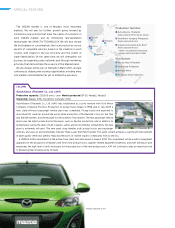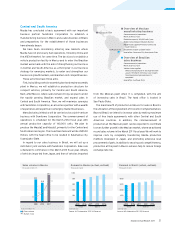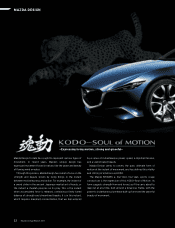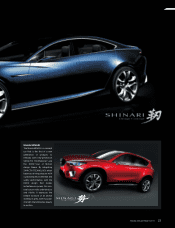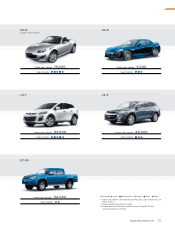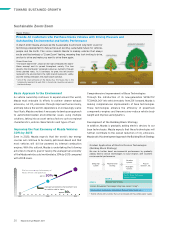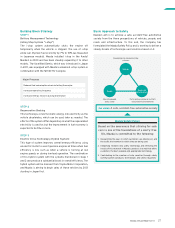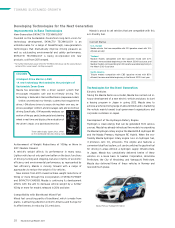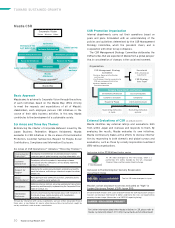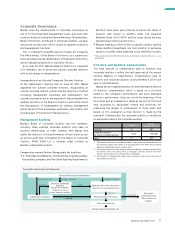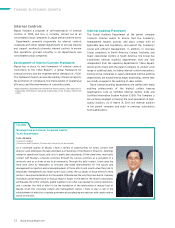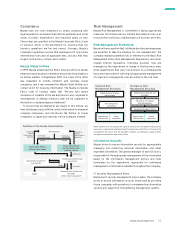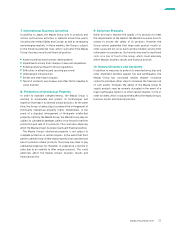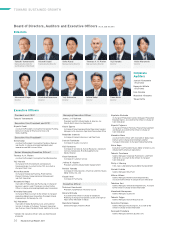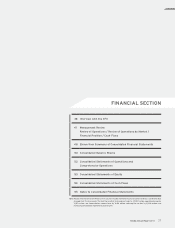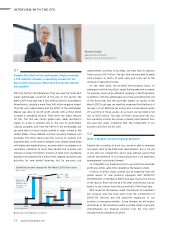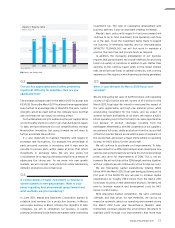Mazda 2011 Annual Report Download - page 31
Download and view the complete annual report
Please find page 31 of the 2011 Mazda annual report below. You can navigate through the pages in the report by either clicking on the pages listed below, or by using the keyword search tool below to find specific information within the annual report.
TOPICS
Initiatives in Vehicles
Research and Development toward Creating Safer
Automobiles
In order to comply with safety standards in countries around
the world and to meet the criteria of NCAP* safety assessment
tests, Mazda carries out numerous evaluation tests such as
crash tests, rollover tests and roof strength tests. The
Company’s goal is to develop safer vehicles by minimizing
damage in the event of an accident.
* Abbreviation of New Car Safety Assessment Program. It is an official crash test
program for new vehicles conducted in major countries around the world. The safety
of new vehicles is evaluated through simulated collisions.
Active Safety Technologies
Active safety technologies help drivers anticipate and avoid
accidents. Mazda is undertaking technology development and
implementing the various technologies from a range of
perspectives.
Pre-Crash Safety Technologies
Pre-Crash Safety Technology helps vehicles minimize the
impact and damage from a collision, in order to reduce injury
to the driver and passengers as much as possible when an
accident cannot be avoided.
Passive Safety Technologies
Passive safety technologies help mitigate injuries of the driver
and passengers if an accident should occur. Mazda does much
more than simply comply with the laws of each country and
region; it also conducts tests for various types of potential
collisions that may occur on the road, and has made steady
progress in developing passive technologies for better protec-
tion of passengers and drivers.
Initiatives with People
Safety Education (in Japan)
Mazda is endeavoring to raise safety awareness among adults
and children through safety-related exhibitions at the Mazda
Museum in the Hiroshima Head Office, through the “Kids’ Quiz
on Traffic Safety” website for children, and other projects.
Initiatives in Roads and Infrastructure
Initiatives toward Realizing a Safe Automotive Society
with ITS (in Japan)
Intelligent transport systems (ITS) use telecommunications
technology to bring together cars, people, and the traffic
environment. They have the potential for easing traffic congestion
and reducing the number of accidents throughout Japan.
As an automotive maker, Mazda is actively participating in
Japan’s ITS project in cooperation with national government
and local government bodies as well as related companies and
the community in order to achieve a safe automotive society
for everyone. By expanding the “ITS Spot services”*1 system,
mainly on the highway throughout Japan by March 201 1,
Mazda and other automakers are working together with the
Ministry of Land, Infrastructure, Transport and Tourism to
promote widespread use of the system.
Furthermore, Mazda participates in the “Smart Traffic Flow
Control” project*2 from not only a safety perspective, but also
from an environmental protection perspective.
*1. This system has been mainly built on the highway in 1,600 spots throughout Japan
and entered service in March 201 1. The system provides various information
including a wide range of traffic information and images by using high-speed and
large-capacity road-vehicle communication, in which signals are trans mitted
between vehicles’ navigation systems and ITS spots on the road infrastructure.
*2. A traffic flow management system that utilizes intelligent vehicle driving control to
promote safety while ensuring a smooth, continuous flow of traffic.
Safety Initiatives
Premacy Awarded Six Stars by JNCAP; Mazda3 Chosen as an IIHS
201 1 Top Safety Pick
In April 201 1, the Premacy (overseas name: Mazda5) was awarded a total of six
stars, the highest rating by the Japan New Car Assessment Program (JNCAP)*1
as a result of crash tests evaluating occupant safety for the vehicle (awarded
based on Japanese model specifications).
In March 201 1, the U.S.-based Insurance Institute for Highway Safety (IIHS)*2
evaluated the Mazda3 (Japanese name: Axela) through crash testing and chose
it as a 201 1 Top Safety Pick in small cars, a top honor (awarded based on
American model specifications). The Mazda3 received the top rating of “Good”
in the crash-test categories of frontal collision, side collision, whiplash (neck)
injury prevention, and roof strength during a rollover accident, achieving safety
performance that is among the best in the world.
*1. A vehicle safety performance-testing program operated by the National Agency for Automobile Safety
and Victim’s Aid (NASVA). By evaluating safety performance of vehicles available in the market through
testing and making the results public, NASVA strives to create an environment in which users can
choose safe vehicles and in which safer vehicles become more widespread.
*2. A nonprofit organization active in the U.S. insurance industry that performs safety evaluations.
Mazda3
Premacy
Mazda Annual Report 201 1 29



